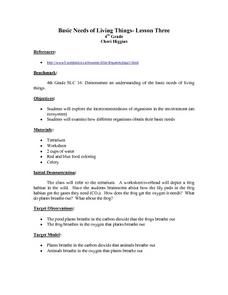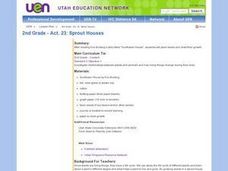Curated OER
Where We Live
Who has the most? Young learners practice charting data using familiar information. They help fill out a classroom chart by recording the number of people, pets, televisions, etc. in their home. Guiding questions help them investigate...
Curated OER
The Differences Between Turtles and Tortoises
First graders differentiate between turtles and tortoises. In this turtles and tortoises lesson students are visited by a turtle and a tortoise. Students write a letter with an illustration after the animals visit the class.
Curated OER
Everybody Needs
Students compare cultures. In this needs and wants lesson, students discuss the basic necessities of life and what they need in a day in order to survive. Students also discuss how these needs might change if they lived in another...
Curated OER
Basic Needs of Living Things-Lesson Three
Fourth graders explore the interconnectedness of organisms in the environment and examine how different organisms obtain their basic needs. They discuss a frog's habitat and what is found in it. Students discuss the processes of...
Curated OER
Needs and Wants
Students examine the difference between needs and wants. In this consumption lesson, students illustrate their needs and wants and discuss their own reasons for buying things. They also discuss the connection between their choices and...
Curated OER
Needs & Wants
Second graders determine the definitions of needs and wants. They write the definitions down and make a personal list explaining their own wants and needs. They cut out pictures from magazines showing their wants and needs which they...
Curated OER
Hunters and Gatherers
Sixth graders participate in mapping and other activities to understand why ancient civilizations developed as they did. In this ancient civilization lesson, 6th graders recognize that there were three important climate zones and...
Curated OER
Health and Growth
Students recognize that living things need food and water. In this health and growth lesson, students identify foods that are better for health and growth. Students sing a song and complete a worksheet. Students understand that they...
Curated OER
What Would You Do If?
Young scholars investigate the concept of how nature needs to be conserved. They examine how man has had a positive and negative impact. Students work in teams to make up scenarios with problems and then propose environmental solutions.
Curated OER
The Needs of Living Things
Students investigate the global food chain by creating a visual chart. For this ecology lesson, students discover the elements needed for life to sustain itself, contrasting living things vs. non living things. Students fill in a...
Curated OER
Cells
Third graders investigate yeast to extend their understanding of living and non-living things.
Curated OER
Is It Alive?
Eighth graders define the boundaries of living organisms. They determine what makes something a living organism and identify factors that constitute "living." Pupils write a conclusion about the evidence they found that yeast is alive...
Curated OER
Investigation 2 - Greenhouses
Third graders set up a miniature greenhouse to help them explain how nonliving things affect the growth of living things.
Science Matters
Oh Heron
Two teams—the environmentalists and herons—play four rounds of the game, Oh Heron. Using hand symbols to represent food, shelter, and water, players locate their match to produce more herons while those unmatched decompose.
K12 Reader
Ecosystems
Examine how living and non-living things work together in a reading passage about ecosystems. Class members read the text and then respond to five response questions that relate specifically to the content of the passage.
Curated OER
Investigate Science Using Crayfish
Young scientists discover the importance of scientific investigation by observing live crayfish. They carefully observe the patterns of crayfish in different environments. Then they discuss their conclusions and define what all living...
Curated OER
Help the Duck Find Her Babies
Students are introduced to a basic characteristic and need of living things-the ability and need to reproduce. They investigate how birds (and people) attract mates. Students discover how to build a nest. They discuss the needs and...
Nature New Brunswick
Habitat for Endangered Wildlife and You
Compare and contrast your habitat with that of endangered plants and animals! Learners discuss what a habitat is actually comprised of, describing what theirs looks like. They fill out a graphic organizer explaining what they eat, how...
Curated OER
2nd Grade - Act. 23: Sprout Houses
Read the story "Sunflower House," by Eve Bunting with your 2nd graders to investigate the relationships between plants and animals. They will discover how living things change during their lives by creating their own sprout houses. In...
Curated OER
What Are Cells?
Energize the cells of young biologists with an edible life science activity. Engaging learners in exploring the inner workings of plant and animal cells, this activity involves using colored jello and various sweet and tasty treats to...
Curated OER
Meet the Plants
Learners examine the difference between living and non-living things. In this living versus non-living lesson, students complete a KWL worksheet and a Living and Non-Living Chart. They examine a variety of plants and non-plants before...
Curated OER
Biology: living Things and their Environment
Middle schoolers recognize that organisms depend on other organisms. In this organism lesson, students understand symbiotic relationships and competition. Middle schoolers explain food chains and food webs. Students understand that...
Curated OER
What Lives in the Forest?
Students investigate nearby forests and record their interactions with trees as well as wild life. For this ecology lesson, students read the book, In the Woods: Who's Been Here?, and attend class observational field trips through their...
Curated OER
Urban Life: What Lives In Our Local Park?
Fifth graders participate in activities during a visit to Central Park. In this urban life lesson, 5th graders visit Central Park where they explore pond dipping, stream chemistry, and play a native plant Bingo game.

























